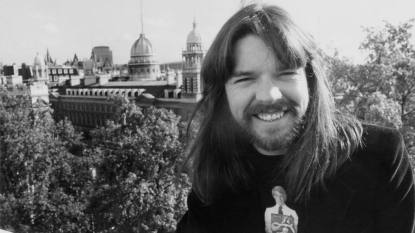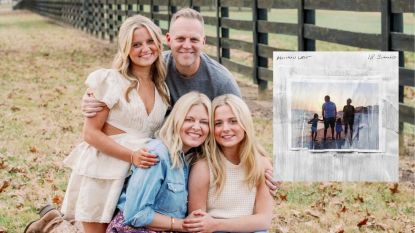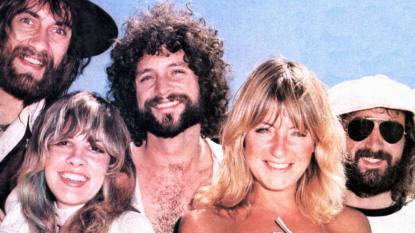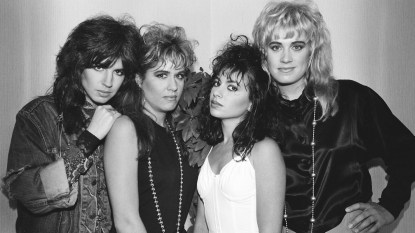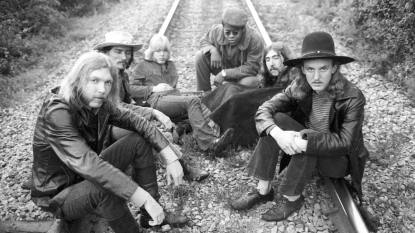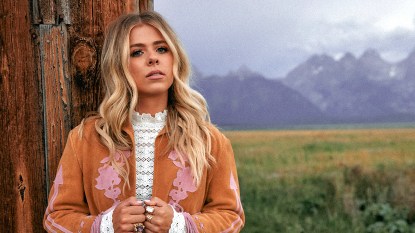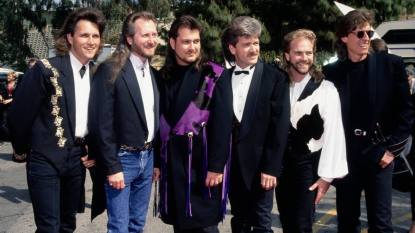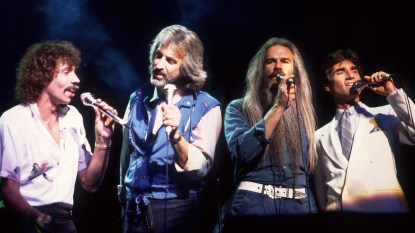20 Greatest Garth Brooks Songs Of All Time— And the Fascinating Stories Behind Them
From 'Friends in Low Places' to 'Rodeo' to 'The Dance' you'll be singing along to these Garth classics!
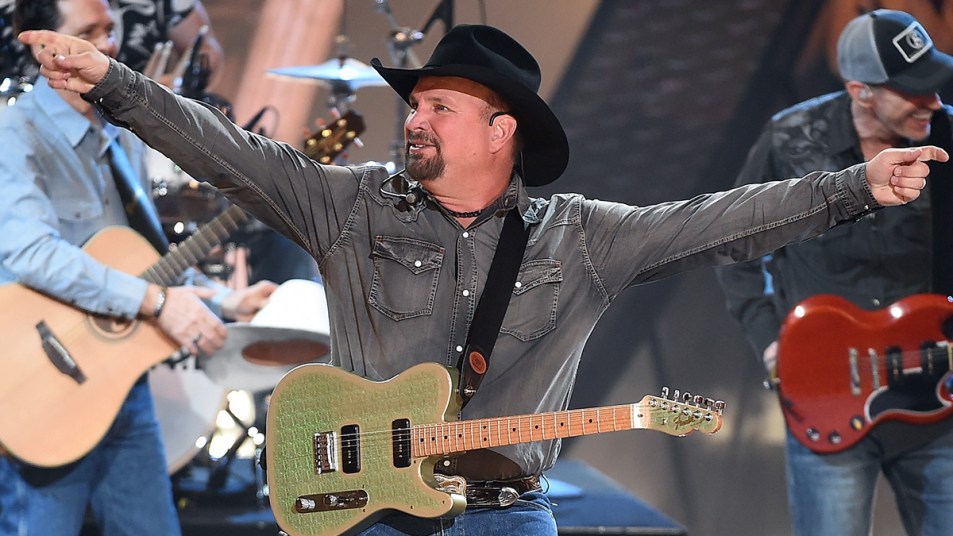
Before the awards and accolades and sold-out arenas, Garth Brooks was just a humble performer telling stories through his songs. In the late 1980s, he launched his stuff-of-legends career at Nashville’s renowned Bluebird Cafe, an intimate music venue wherein guests sit eye-level with — and very close to — musicians and songwriters, and get to listen in on the behind-the-scenes tales of how their favorite songs came to life. Beyond being a charismatic live performer, Garth Brooks songs have become the stuff of legend.
Related: Garth Brooks Opened A New Nashville Honky-Tonk — And He Gave Us A Personal Tour!
Over the years, he’s written or co-written some of his most beloved hits such as “Unanswered Prayers,” which he wrote with Pat Alger and Larry Bastian and “The River,” which was penned with singer/songwriter Victoria Shaw.
However, Garth’s also known as a champion of other songwriters and when he hears a great song, he’s eager to record it whether he’s a writer on it or not. “More Than a Memory” was written by country hitmaker Lee Brice, Billy Montana and the late Kyle Jacobs. Songwriter Tony Arata wrote “The Dance,” and Garth recorded it after hearing Tony perform the song at Nashville’s famed Bluebird Cafe.
Currently, Garth Brooks is performing songs in his Las Vegas Residency, Garth Brooks/Plus ONE, at Caesars Palace. Beginning on May 18 and lasting until 2024, fans are promised a “once-in-a-lifetime performance each and every night,” according to the venue’s website. “When the 2023 shows went on sale, I felt extremely fortunate and blessed. To even think I would get do this for another year makes me happier than I can explain. Thank you for the chance,” Brooks said in a statement.
Still ever so humble despite the fame, Brooks even returns to his roots at the Bluebird Cafe periodically, as he did in early 2023, when he surprised attendees with an unannounced appearance and performance. We may not all be so lucky but we can still enjoy the amazing Garth Brooks songs. Here the incredible stories behind 20 of his most enduring hits.
1. “Much Too Young (To Feel This Damn Old)” (1989)
One of the songs that Garth Brooks brought with him to Nashville in 1987, “Much Too Young (To Feel This Damn Old)” was originally supposed to be about a road-weary musician. “That’s pretty good,” his friend Randy Taylor told him. “But it could be better.”
Taylor suggested that what it needed was a cowboy. So Garth flipped the script and opted to use one of his heroes, ex-rodeo champion Chris LeDoux, as the inspiration for the main character. It was a stroke of genius.
As the first single Garth released, it established him as a country singer with a very unique sort of authenticity, one that evoked the Great Plains and America’s heartland. LeDoux got name-checked directly in the song, a fact that Garth claimed helped give himself some credibility, but it proved mutually beneficial. With Garth’s help, LeDoux signed his own Capitol Records contract. The two later collaborated on 1992’s “Whatcha Gonna Do With a Cowboy.”
2. “If Tomorrow Never Comes” Garth Brooks songs (1989)
Another cut that Garth had come up with before he left Oklahoma for Music City, this one didn’t come to life on the page until he met Kent Blazy, a Nashville songwriter. Garth had tried shopping the idea around to several other songwriters in Nashville, none of whom took an interest in it. But when he had his first meeting with soon-to-be-manager Bob Doyle, Doyle introduced him to Blazy.
“He had the first verse down within 15 seconds. I could tell he just felt it,” Garth recalled in the liner notes to The Hits, a 1994 compilation album. Though the finished product grew into a rumination on a father imagining what life would be like for his daughter once he’s gone, the roots of “If Tomorrow Never Comes” laid in the real-life deaths of two of Garth’s close friends from college, Jim Kelly and Heidi Miller — a onetime roommate of Garth’s — who died in a plane crash and car accident, respectively, in the mid-’80s. As his first love song and slow ballad and his first No. 1, it would hold a pivotal place in his musical development.
3. “The Dance” (1989)
Picking out one singular song as Garth’s defining hit is a near impossible task. However, “The Dance” would probably be your best bet. The singer has even said so himself, telling Playboy in 1994, “I’ll go to my grave with ‘The Dance.’ It’ll probably always be my favorite song.” Ironically, it took some convincing to get him to include it on his self-titled debut. Here, it appeared as the closing track and would ultimately serve as the final single.
Songwriter Tony Arata penned the song. He later wrote Clay Walker’s 1994 No. 1 “Dreaming With My Eyes Open” and Garth’s “The Change,” which reached the top two years after that. Still, when the time came, Garth and producer Allen Reynolds insisted it would be a perfect single. Its overwhelming success set him up for the one-two punch of “Friends in Low Places.” It also earned him his first Song of the Year award from the Academy of Country Music in 1990.
4. “Friends in Low Places” (1990)
Garth’s debut album did its job in establishing the up-and-comer as a singer and songwriter of great emotional depth and nuance. However, with the heft of “The Dance” helping put him over the edge, he needed to show fans his fun, carefree side. “Friends in Low Places” did that, and then some. It’s hard to imagine his catalog, much less one of his live shows, without this woozy, infectious sing-along. It actually got its title from a dinner that co-writer Earl Bud Lee had with a friend.
“Don’t worry,” the pal said when they got the check. “I have friends in low places. I know the cook.” It’s not surprising that its runaway success actually started as a word-of-mouth campaign. Radio disc jockeys latched onto the track before it had even been released as a single; this was thanks to Garth’s mother, Colleen, accidentally leaking it. Soon, listeners were calling into stations demanding to hear it played.
5. “The Thunder Rolls” Garth Brooks songs (1990)
Though inextricably linked with the music video that stirred up so much controversy for its depiction of domestic violence, “The Thunder Rolls” was yet another of Garth’s original compositions from his early days in Nashville. It was initially given to another artist — in this case, no less than outlaw bad girl Tanya Tucker, who recorded it in 1988 for that year’s Strong Enough to Bend.
Tucker, uniquely, asked for an additional verse to be added. Garth and his co-writer, Pat Alger, duly accommodated her request. Yet Tucker ultimately decided against including the song on her album, which came as a relief to Reynolds. “That’s one of the most powerful songs I’ve ever heard!” he insisted. So Garth cut the song himself, minus the extra verse, for No Fences, with Alger joining in on acoustic guitar. After being released as a single in April 1991, the song became Garth’s fifth straight country No. 1.
6. “Unanswered Prayers” (1990)
This beautiful ballad was written by Garth, Pat Alger and Larry Bastian. The lyric tells the story of a man who runs into his old high school flame at a hometown football game and introduces her to his wife. The song was inspired by a real life event.
In the liner notes for his 1993 collection The Hits, Garth shared, “Pat Alger and I worked on this song quite a long time without a hook, without the line. We passed it by Larry Bastian and it was as if it was meant to be. Larry, his wife Myrna and I were taking a walk down 18th Avenue, and he looked at me and said, ‘Oh, that’s simple. This song should be called ‘Unanswered Prayers’ because some of God’s greatest gifts are unanswered prayers.’ This is probably the truest song I have ever been involved with as a writer. This actually happened to my wife and me when we went back home to Oklahoma. Every time I sing this song, it teaches me the same lesson… happiness isn’t getting what you want, it is wanting what you’ve got.”
7. “Shameless” Garth Brooks songs (1991)
Written by Billy Joel, this song was originally recorded on Joel’s 1989 album Storm Front. Garth recorded it on his third studio album, 1991’s Ropin’ the Wind. The song became his seventh No. 1 hit.
He shares this in The Hits liner notes: “’Shameless’ was the longest shot we took with a song. I was talked into becoming a member of a CD club…you know, the 40,000 CD’s for a penny deal. With those clubs, they write you with the selection of the month. If you don’t write back and cancel, then they send it to you and charge you for it. I was on the road for six months with no one to check the mail and came home to find six compact discs in my mailbox. Storm Front by Billy Joel was one of them.”
He continues, “I hadn’t listened to Billy Joel since the late seventies, probably since Glass Houses. I fell in love with the album and fell back in love with Billy Joel’s music. One of his songs really captured me, a song called ‘Shameless.’ I kept watching it, and when he did not release it as a single, we contacted his people in the hopes that we could cut it. His people sent us a letter acknowledging that he knew who I was and was very honored that I was cutting it. That was quite a compliment for me then, as it is now.”
8. “The River” (1991)
Besides being a world-class entertainer and all-around good guy, Garth is also a tireless cheerleader for his legions of fans, hoping they pursue their dreams and live their best lives. Never was that clearer than on “The River,” the standout track from his sensationally successful third album, Ropin’ the Wind. Ever intent on finding new imagery in his writing and inventive ways to articulate some of the world’s biggest ideas, the song uses its namesake as a metaphor for the creative process and the pursuit of one’s dreams.
“I live by this song every day and hope it gives courage to people who have ever been in a fight they didn’t know they could finish,” Garth said. He co-wrote it with one of his favorite writing partners, singer-songwriter Victoria Shaw, with whom he later penned the No. 1 “She’s Every Woman.” Trisha Yearwood also covered Shaw’s “Where Your Road Leads” in 1998, with Garth providing backing vocals.
9. “What She’s Doing Now” (1991)
Co-written with Pat Alger, this tender ballad was the third single from Garth’s 1991 album Ropin’ the Wind and it spent four weeks at the top of Billboard’s Hot Country Singles & Tracks chart. Garth wrote this in the liner notes for The Hits: “‘What She’s Doing Now’ was an idea I had a long, long time about a man wondering what a woman was doing. And it was very simple. What is she doing now? Is she hanging out the clothes? Is she running a business? Is she a mother? Is she married? Who is she with? When I told the idea to Pat Alger, he looked at me with a smile and said, ‘I wonder if she knows what she’s doing now to me?’ When I heard that, the bumps went over my arms and the back of my neck, and I knew that he had something.”
He continued, “Crystal Gayle cut this song back in 1989. It came back to us for the Ropin’ the Wind album. It is a song that has crossed all boundaries and borders around the world. This has made me extremely happy because the greatest gift a writer can ask for is to relate to someone. I can’t help but think that this song might relate to a lot of people.”
10. “Rodeo” (1991)
The infectious uptempo number was written by Larry Bastian and has long been a favorite in Garth’s live shows. ‘Rodeo’ was the first single from Garth’s hugely successful album, Ropin’ the Wind. His love of rodeo has never been a secret and Garth had to say this about the song in his liner notes for The Hits: “If one looks down the list of music’s greatest writers of all time, I couldn’t imagine the list being complete without the name of Larry Bastian. The song ‘Rodeo’ was originally titled ‘Miss Rodeo.’ It was a female song, where the artist sang about how she could not compete with the sport of rodeo.
He continued, “I tried to get every female I know in the industry to cut this song. When the last told me she just didn’t hear it, I began to wonder if that meant I was supposed to do something with it. This song was recorded in 1981 as a demo, and for ten years, it sat silent. We got a hold of it, and the band’s version of it just stunned me. This song has always been a favorite live, and I hope as long as I get to play live, this will always be on the list.”
11. “We Shall Be Free” (1992)
Co-written by Garth and Stephanie Davis, this inspiring anthem was the first single from his album The Chase. In addition to becoming a country hit, the song also crossed over to the Christian charts and it also earned Garth a 1993 GLAAD Media Award.
“’We Shall Be Free’ is definitely and easily the most controversial song I have ever done,” Garth said in the liner notes for The Hits. “A song of love, a song of tolerance from someone who claims not to be a prophet but just an ordinary man. I never thought there would be any problems with this song. Sometimes the roads we take do not turn out to be the roads we envisioned them to be. All I can say about ‘We Shall Be Free’ is that I will stand by every line of this song as long as I live. I am very proud of it. And I am very proud of Stephanie Davis, the writer. I hope you enjoy it and see it for what it was meant to be.”
12. “That Summer” (1993)
This chart-topping hit was written by Garth with his first wife Sandy Mahl and longtime friend and collaborator Pat Alger. The lyric tells the story of a teenage boy who goes to work on a lonely widow’s farm and romance blossoms. In his 1996 television special, The Garth Brooks Story, he shared the story behind the song.
“’That Summer’ started out as a single guy and a married woman meeting at a party. The married woman being ignored by whom she was with, and they snuck off together. [Producer] Allen Reynolds told me, ‘Man, I just don’t find myself pulling for these characters. It doesn’t seem innocently cool.’ I was thinking that he was right. Going home that night in the truck I started singing she has a need to feel the thunder. Sandy started helping me write the chorus and we got the chorus done. Probably one of the neat things that I love about ‘That Summer’ is that I think the song is very sexy.”
13. “Standing Outside the Fire” Garth Brooks songs (1993)
Co-written by Garth and Jenny Yates, this powerful anthem was the third single from Garth’s album In Pieces. It peaked at No. 3 on the chart. The inspirational song boasts the memorable line: “Life is not tried, it is merely survived if you’re standing outside the fire.”
In his liner notes from The Hits, Garth writes, “I was in Los Angeles in 1992, hanging out with a good friend, Jenny Yates. In a conversation I was describing something that I thought was really close, but for me it just stood outside the fire. There was that brilliant moment of silence when we just looked at each other and smiled. Within an hour and half, this song was written. This is another song of inspiration, and Jenny is that way when it comes to inspiration. I don’t know if I have ever met a bigger dreamer than Jenny – to the one who saw the vision and made it happen – my hats off to Jenny Yates.”
14. “Ain’t Going Down (Til the Sun Comes Up)” (1993)
After the deep introspection of The Chase, his fourth album, Garth was looking to loosen up again when it came time to cut In Pieces. He turned to two of his best friends to help him get there, Blazy and Kim Williams, with whom he’d previously collaborated on the free-wheeling cheatin’ song “Papa Loved Mama” off Ropin’ the Wind.
The three men were relaxing on the front porch of Blazy’s new home in Nashville when they got to talking. “We wanted to write something that was fun, for no other reason than just that: fun,” Garth said. Right there and then, they wrote this story about a girl who stays out past her curfew and winds up getting grounded because of it. “Ain’t Goin’ Down (Til the Sun Comes Up)” was a no-brainer as the album’s lead single. It didn’t disappoint by heading straight for No. 1 in September 1993.
15. “Calling Baton Rouge” (1994)
Written by Dennis Linde, this rousing bluegrass flavored song has been recorded by multiple artists including New Grass Revival, Billie Jo Spears and The Oak Ridge Boys. Garth Brooks recorded it as one of the songs for his 1993 album In Pieces, and it climbed to No. 2 on the US Country charts and hit No. 1 in Canada.
In the liner notes for The Hits, Garth wrote, “I have always been a fan of ‘Baton Rouge.’ I was, still am, and always will be a fan of the members of New Grass Revival, four guys well ahead of their time (even if they came out thirty years from now). ‘Baton Rouge’ was a single for them about the time my first album was released. This song did not even break the top thirty, and I believe it did not get a fair shot.”
He continued, “When we recorded it, it seemed only natural to bring in the guys from New Grass Revival – Pat Flynn, Bela Fleck, John Cowan, and Sam Bush, teamed with Jerry Douglas. This was the first time the New Grass Revival had been together since their breakup over a year prior to the recording of this song. It was a very good day and an extremely proud moment, and I think this is reflected in the cut itself.”
16. “The Beaches of Cheyenne” (1995)
This is one of the saddest Garth Brooks songs, and arguably the saddest country song, ever written. It tells the story of a couple who have a fight and the woman hurls some pretty harsh words as the man leaves, telling him she doesn’t give a damn if he ever comes back from Cheyenne. And sadly, he never returns.
Competing in a rodeo, he’s killed by a bull that “no man could ride.” She goes crazy when she gets the news and in her grief, she runs out into the ocean. They never find her body, just her footprints in the sand and her diary by the bed chronicling her last words to him.
Garth co-wrote the song with Bryan Kennedy and Dan Roberts. It was the third single from his album Fresh Horses and became his 15th No. 1 hit. On the 1995 TV special, The Garth Brooks Story, Garth explains the story behind the song. “[It was] supposed to be real funny. Kind of like cowboys on the beach, kind of, swingin’ kind of thing. Then it went to a guy on the beach that would come home from a suit and tie job. He never had any cowboy talents, but he always wanted to be one. So, he just comes home, slips off his shoes and goes out and walks on the beach and dreams of Wyoming and stuff. Then out of just a fluke, one time passing through, it came with…every night she walks the beaches of Cheyenne. We looked at each other and said, ‘This ain’t gonna be funny, boys.’”
17. “Two Piña Coladas” (1997)
If “Two Piña Coladas” seems to effortlessly evoke warm vibes and visions of relaxing on the beach, that’s no accident. Another more upbeat of the Garth Brooks songs was cut on a particularly cold and dreary day in Nashville by Shawn Camp, Benita Hill, and Sandy Mason, who wanted nothing more than to escape to someplace sunny. Not surprisingly, they figured it would be perfect for Mr. Piña Colada himself, Jimmy Buffet. However, Allen Reynolds had other ideas.
He insisted it would be a good fit for Garth, who had no trouble leaning into the party atmosphere. Garth took the song right to No. 1 when it was released as a single in March 1998. He liked the song so much that he picked up another of Hill’s compositions, “Take the Keys to My Heart,” which helped Hill pay off her credit card debt. It was a boost for Camp as well, who had another chart topper later that year with Brooks & Dunn’s “How Long Gone” and later wrote hits for Blake Shelton, Josh Turner, and George Strait.
18. “In Another’s Eyes” Garth Brooks songs (1997)
Recorded with his wife Trisha Yearwood, this powerful ballad was featured on Trisha’s album Songbook: A Collection of Hits. Garth wrote the song with Bobby Wood and John Peppard and it climbed to No. 1 on the chart.
At the 40th Grammy Awards, Garth and Trisha took home the award for Best Country Collaboration with Vocals. Here’s a look at the couple, who were married in 2005, performing on The Tonight Show with Jay Leno. (Click through to read more about Garth and Trisha’s family)
19. “To Make You Feel My Love” Garth Brooks songs (1998)
This Bob Dylan cover isn’t necessarily the most obvious choice as one of the most well known Garth Brooks songs, and Garth himself agreed — at least at first. Hope Floats director Forest Whittaker and the soundtrack’s producer, Don Was, brought the song to him. They saw it as the anchor track for this romantic drama starring Sandra Bullock and Harry Connick Jr. “I don’t hear this as a Garth Brooks song,” he mused. But when Garth sat down with the lyrics, he began to appreciate its simplicity.
Dylan had released it on his late-period comeback Time Out of Mind, and Garth fave Billy Joel had already covered it. The country star gave one of his all-time great performances as a vocal interpreter, really delving into the emotional space left open by Dylan’s spare lyrics. The song served as the soundtrack opener. It was bookended by another recording of the song by none other than Trisha Yearwood. It has since become a modern standard, made more famous still by the likes of Adele.
20. “More Than a Memory” Garth Brooks songs (2007)
After “To Make You Feel My Love,” the well ran dry on No. 1 hits for Garth, though it would’ve once seemed impossible to believe he’d be anywhere other than the top of the charts. In the nearly 25 years since that song was released, the country king has had just one more No. 1 single to his name, bringing his career total to 19.
That came courtesy of his 2007 cut, “More Than a Memory,” one of four new Garth Brooks songs that were recorded especially for that year’s The Ultimate Hits compilation. It debuted at No. 1, remarkably making it the first song ever to do so on the country chart, and the only one to do it based solely on radio airplay. (The metric would later be changed to include streaming figures.) The tune also marked a breakthrough for one its writers, future country hitmaker Lee Brice.
A version of this article appeared in our partner magazine Garth Brooks, with additional details from writer Deborah Evans Price
In the mood for more country music? Keep reading!
The Top 20 Patriotic Country Songs That’ll Make You Feel Proud to be an American
Trisha Yearwood on Getting COVID-19, Her Marriage to Garth Brooks, and How God Has a Plan
Trisha Yearwood and Garth Brooks Are #CoupleGoals — Here’s the Scoop on Their 40-Year Story

Deborah Evans Price believes everyone has a story to tell and, as a journalist, she considers it a privilege to share those stories with the world. Deborah contributes to Billboard, CMA Close Up, Jesus Calling, First for Women, Woman’s World and Country Top 40 with Fitz, among other media outlets. Author of the CMA Awards Vault and Country Faith, Deborah is the 2013 winner of the Country Music Association’s Media Achievement Award and the 2022 recipient of the Cindy Walker Humanitarian Award from the Academy of Western Artists. Deborah lives on a hill outside Nashville with her husband, Gary, son Trey and cat Toby.



